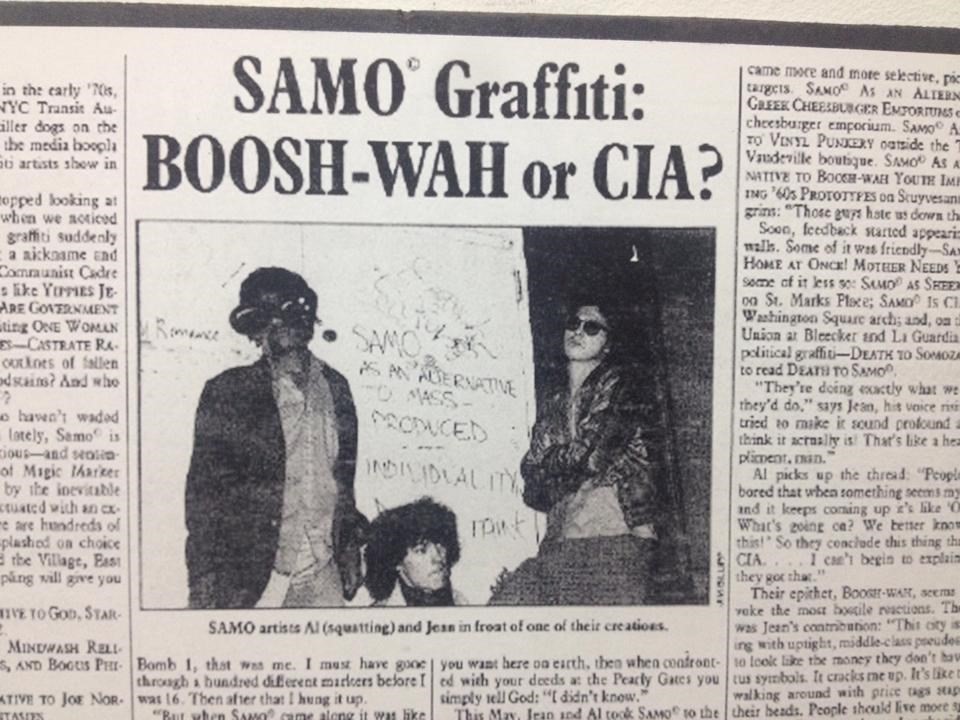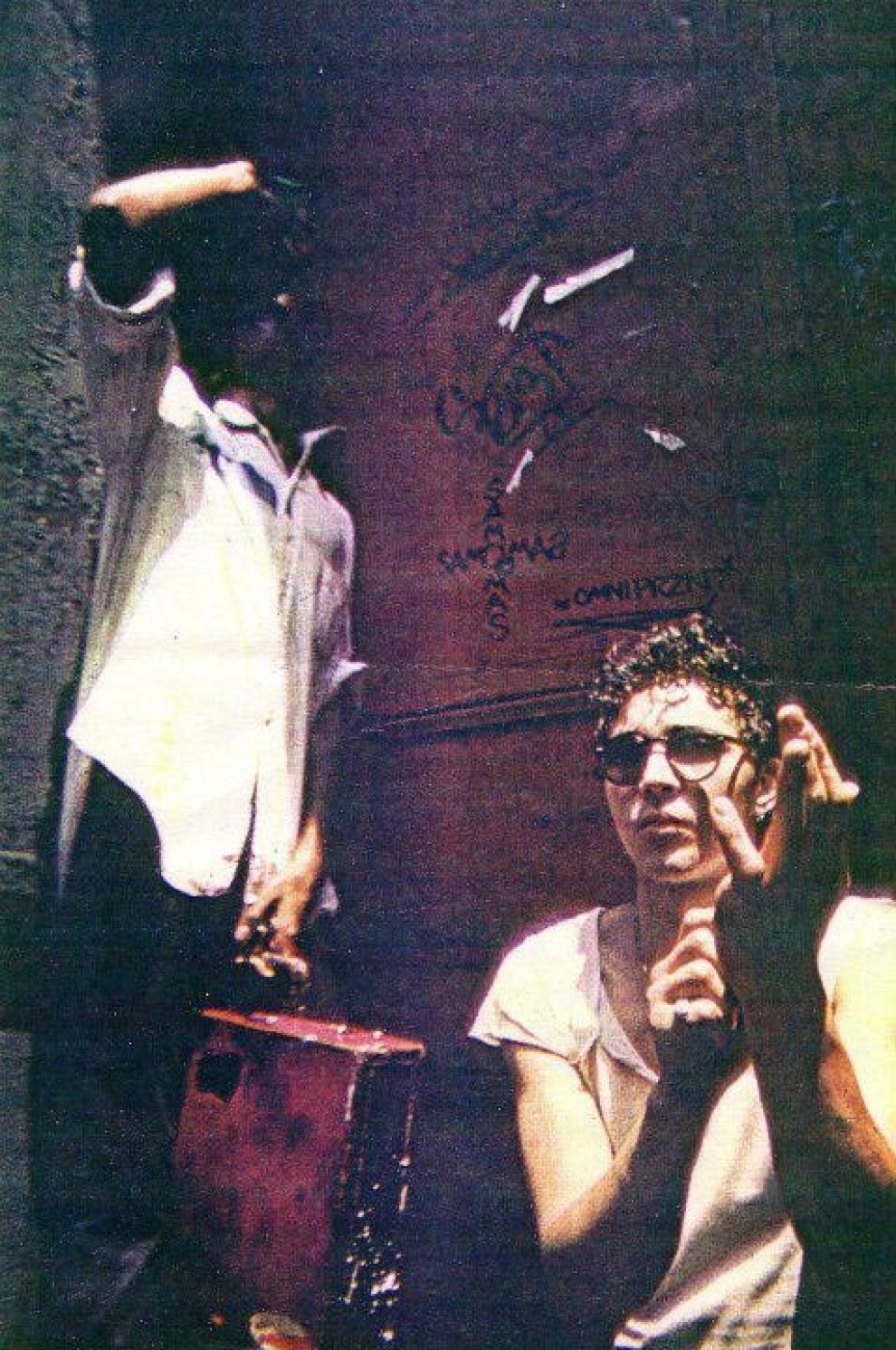In the late 70s, when graffiti tagging was in full swing across New York, the word ‘SAMO©’ began cryptically appearing – sprayed on the city’s walls.
“SAMO©,,, AS AN END TO THE 9 TO 5 “I WENT TO COLLEGE” “NOT 2-NITE HONEY”,,,BLUZ’,,,THINK,,,”
“SAMO©,,, 4 THE SO-CALLED AVANT-GARDE”
“SAMO©,,, AS AN ALTERNATIVE 2 ‘PLAYING ART’ WITH THE ‘RADICAL CHIC’ SECTION OF DADDY’$ FUNDS,,,”
The new style countered the name and street number format that had so far reigned supreme. Behind the words were two teens named Al Diaz and Jean-Michel Basquiat, who collectively identified as SAMO© and used the moniker as a channel for their angst. It was witty, confusing, confronting – it got people’s attention.
While Jean-Michel Basquiat went on to become the Jean-Michel Basquiat, SAMO©’s influence on his career is something rarely explored. Not a single work of the late artist’s exists in a UK public gallery nor has a major exhibition been held on his work until later this month – the Barbican will open a major retrospective that will cover the many facets of Basquiat’s art and life, including his time spent as one-half of SAMO©, alongside Diaz. Sadly, SAMO©’s writings have long been painted over or scrubbed away, with Diaz telling me over the phone from New York, “I certainly don’t know of any but it would be great if there was.” He adds that if there were any, they’d likely be hidden in a basement somewhere.
Long before the pair met, Diaz was a fully fledged member of New York’s graffiti movement. Raised in a housing project on the Lower East Side (“It was a real shithole then”), Diaz began writing graffiti on trains and buses at age 12. “I was writing Bomb 1,” he recalls. “The old graffiti format was a nickname and then a number, which was sometimes your block, the street you lived on, or the building. It showed where you were from.” During its inception, the graffiti movement was limited to NYC with sproutings in Philadelphia. “It was not the refined street culture it has become,” Diaz continues. “It wasn’t an international phenomenon, it was an inner city thing in the side boroughs, like a kind of secret organisation. It was a sport. A way to be cool and different. No-one had been doing it before. There had never been a phenomenon of going around writing your name on the wall as many times as you could so people would notice it.”
Diaz’s reasons for doing it were just this – to become someone that people knew. “Before people would go around writing gang names, such as ‘Sharks’ or ‘Jets’, but this was all about ‘you’. And I was looking for an identity. I wasn’t a very good athlete or anything, and I liked to draw. But at the same time, I liked to run around in the street, get chased, and get into trouble… It was perfect.”
It was in high school that Diaz met Basquiat. “He was shy around the more aggressive types, like the skateboarders or the graffiti arists,” recalls Diaz. “He wasn’t a tough guy or anything. But with his own circle of friends, he was pretty outgoing. Somehow, we really hit it off (because) we just kind of had the same sense of humour.” The friends shared musical and artistic interests, and both held Hispanic roots. “It was enough to cement our friendship,” says Diaz. “We were both big on words and language, and that really did it. I don’t know if we were aware of it at the time, but it was definitely something.” Attending an alternative high school in Brooklyn Heights, Diaz and Basquiat spent their time visiting the city’s museums. “If you needed art credit, you could do a course where you would go to MoMA, or something, and Jean and I did that class together. But he was real problematic – he was always arguing with this woman called Sylvia, who conducted the tours,” laughs Diaz. “I always wondered if she remembered a young Jean-Michel and later on put two-and-two together and thought, ‘oh fuck, that guy became famous.”
Combining their interests in art, Diaz and Basquiat, along with some other students, started a newspaper named Basement Blues Press. It was here that SAMO© was conceived, through an article that Basquiat was working on for the Spring 1977 issue about an ideal yet imaginary religion that he called SAMO. The feature details a fictional dialogue between Harry Sneed and Quasimodo Jones – sat in the American food chain Papaya King, Sneed talks of a desire for “modern and stylish” enlightenment. Jones tells Sneed about various religions, but is enamoured by the idea of “SAMO”, “a guilt free religion”. A few days after the article was published, Diaz and Basquiat printed out flyers that featured fictional testimonials from people who claimed that converting to SAMO changed their lives. “We thought it was hilarious”, laughs Diaz, “we were just kids.”
The reactions were enough for the friends to keep going with it. Taking the word, “SAMO” – which initially stood for “Same Old Shit” – and turning it into a medium for them to vent frustrations, personal jokes, whatever they wanted, through graffiti. By 1978, SAMO© had begun to appear on walls across the city. “There was a famous graffiti artist that always wrote, ‘Pray and Jesus Saves’ and all these kind of religious things, and I thought we could go about it in that style. We just kept elaborating on it. In a couple of weeks, it was like ‘SAMO© AS AN ALTERNATIVE TO GOD’.” They wrote it on a church on West Broadway, although there is no visual documentation of it now: “Back then, in the 70s, you’re not really thinking, ‘Oh, let’s save this for posterity. That was not really on the agenda,” adds Diaz.
“What we were doing was more like Greco-Roman graffiti, making commentaries on the world around us and that set us aside. We thought we were a little bit ahead of the game” – Al Diaz
“We were commenting on whatever we were dissatisfied with, or thought was funny – whatever! Consumerism, religion, politics. This was all from the mind of someone who was 17 and 19-years-old – we were very young minds.” However, they soon dropped the “Same Old Shit” reference, “because ‘Same Old Shit’ is an alternative to nothing, so it didn’t make any sense.”
“We were trying to be wise guys, funny guys... the smartest guys in the room!” he continues. “We were tired of the name followed by the number format of graffiti because it wasn't saying anything other than ‘Joe 182’ was here. That was the only message there. What we were doing was more like Greco-Roman graffiti, making commentaries on the world around us and that set us aside. We thought we were a little bit ahead of the game.”
Diaz and Basquiat managed to remain completely anonymous until 1978 when they sold their story for $100 to the Village Voice for an article titled “SAMO© Graffiti: BOOSH-WAH or CIA?”, written by Philip Faflick.
“Who the hell was this guy Samo©?”, wrote Faflick, describing the pair as school drop outs. “Does SAMO© in fact provide an alternative?” he asked them, to which they responded, “No way”. “SAMO© is just a means of bringing it out”, explained Basquiat, “a tool for mocking bogusness”. The article also revealed the attention they received at the time, as people wrote their own responses to SAMO©. The positive: “SAMO© CALL HOME AT ONCE! MOTHER NEEDS YOU”, and the less so: “DEATH TO SAMO©”. All of it, they admitted, was taken as a compliment. People even began to believe SAMO© was the CIA – hence the article’s title, “SAMO© Graffiti: BOOSH-WAH or CIA?”. Basquiat added, “We can’t stand on the sidewalk all day screaming at people to clean up their acts, so we write on walls”. Faflick ends with the observation that the pair’s social circle were wary about them speaking with the press, with the writer ominously noting they “were worried that a taste of fame would go to their heads”.

Not long after the Village Voice article came out, things changed. Basquiat appeared on Glenn O’Brien’s off-the-wall TV show, TV Party, with his head half-shaved (reportedly so no-one knew whether he was coming or going) and called himself SAMO©. Diaz was not present. “That was a period when Jean had some kind of ego trip, really strongly,” reflects Diaz, adding that after by 1979 there was a period of about two years when they didn’t speak. “He had picked (SAMO©) up and I’d dropped it. I was playing music Downtown and I couldn’t care less about SAMO© at that point. It was just like ‘fuck the whole thing’. I got a little pissed off because Jean was becoming SAMO©. I was like, ‘oh, he’s calling himself SAMO©’. So yeah, there was animosity between us for some time. Like, ‘Now you’re SAMO©. Oh, I get it.” He laughs. “But it was not like I was telling him to stop doing that though. I was at a different stage.”
While Diaz was making music, Basquiat was fast garnering a following and friendships amongst the art crowd, with people such as Andy Warhol and Keith Haring. As his solo career began to take off, around the early to mid-80s he stopped signing his work with SAMO©, instead using Jean-Michel Basquiat. “I think SAMO© really opened his eyes to the whole 15-minutes of fame thing,” says Diaz. “I believe it was very instrumental – that little flash in the pan we had.”
“He immersed himself very quickly. I mean, he immersed himself. He went from 0 to 90 in two seconds. That’s what he was doing – he was like, ‘I’m an artist’. Actually one night I bumped into him on the street and we hadn’t spoken in a long time – I think he was working on the film Downtown 81. We ended up hanging out and dropping some LSD together. This is when Jean turns and confides in me, saying, ‘Al, I know I’m going to be a famous artist. Not just any artist, a famous artist’. And then he told me he was going to die young. He certainly did both of those things. He had this all very planned in his head. He was very certain about what he was doing. He was very focused and determined and deliberate about his whole everything. That was what he was going to do and that’s what he did.”
By 1983, Basquiat was a phenomenon. His works had appeared at PS1 (in 1981s notorious New York/New Wave), the Larry Gagosian Gallery, the Whitney Museum, alongside others, and he had begun to dabble in film – his first role being the never-released New York Beat. “In 1983, I would stop by Jean’s loft and was kind of privy to his painting career and him becoming an international star. But after 83, he started becoming really busy and lost touch with a lot of his older friends. He was constantly travelling and on the move, so I would see him every now and then, maybe once a year.”
“This is when Jean turns and confides in me, saying, ‘Al, I know I’m going to be a famous artist. Not just any artist, a famous artist’. And then he told me he was going to die young” – Al Diaz
Their time together was rare from then on, but Diaz recalls a visit from Basquiat when he brought a gift that felt like a peace offering. “It was 86, or 87, and Jean showed up at my house and gave me a painting. It was a diptych and it said “To SAMO©, from SAMO©,” he says. “I sold it like an idiot – and I felt really shitty about it. It's one of the things I regret in my life, one of the things I should have thought a little more about because it was made specifically for me. He made it just for me, and I was very callous like it didn't mean anything. I’ve tried looking for it and no one knows where it is.”
On August 12, 1988, 27-year-old Basquiat died at his art studio on Great Jones Street in Manhattan’s NoHo neighborhood. While Diaz pursued separate artistic paths for himself and years later began working on a new project, titled WET PAINT, for which he adopted his own alphabet and used cut up letters and glue to send messages out via the walls of the New York subway system.
SAMO© was seemingly done with – until Trump was elected. “About two hours after the (US) election, the first SAMO© I wrote was, “SAMO©,,, FOR NASTY WOMEN AND BAD HOMBRES,,,”, he reveals. “I was half-mocking and half-dreading the idea of having Trump as our president. So that's what did it, ‘Oh shit, we’re fucked now so I need to start writing SAMO© again.” He adds that it seemed like the most appropriate time. “People had shown so much nostalgia and the younger generation especially had shown interest in SAMO©, so I was evaluating that and I learned that very few people actually got it or understood what we were doing back then, so I wanted to bring it back so people could see what it was.”
Of course, social media has added a new layer that SAMO© in the 70s could never have had. But, however millennial it might feel, Diaz is certain that the essence that was honed by himself and Basquiat, four decades ago, is as strong as it ever was. “You might think it’s a whole different thing but it’s not – I’m keeping it to its original style, purpose. But I’m an adult now. I can be a little more articulate about certain things.”
And while Diaz has been more public as of recently, with new Instagram accounts, an interview in the Barbican’s Boom For Real exhibition book – as well as here, with us – and sharing rarely seen prints with House of Roulx, he is also aware of the beauty in a mystery. “To explain it”, he says, “there’s a paradox, a conflict. You never want to have to over explain it because something about it takes away the magic of it. When someone just gets it, you appreciate that.”






